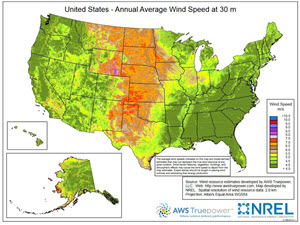Basic Wind Resource and Turbine Siting
Wind turbines require wind to work and wind is influenced by regional, local, and site factors such as terrain, ground cover, and obstructions. It is important to understand the effect that these factors have on the wind resource at the proposed project location.
Resource Maps[section]
[section-item 8]
[row]
[column 12]
Wind maps published by the Department of Energy's National Renewable Energy Laboratory are a good place to start when seeking to understand the wind resource at a local level as these maps provide estimates of wind speeds to within 1km.
[/column]
[/row]
[/section-item]
[section-item 4]
[row]
[column 12]

[/column]
[/row]
[/section-item]
[/section]
MIcro siting
Once the local wind resource has been estimated to be sufficient to power a wind project, care must be taken to evaluate the proposed project site for the specific impacts of terrain and obstructions at the project site.
Microgrids
[image-caption title="NRECA" description="%20" image="https%3A%2F%2Fwww.cooperative.com%2Fremagazine%2Farticles%2FPublishingImages%2Ffull-microgrid-2.jpg" link="%2Fconferences-education%2Feducation-and-skills-assessments%2FDocuments%2Ffull-microgrid-2.pdf" linking="lightbox" center="true" /]
A microgrid is a group of interconnected loads and distributed energy resources that can operate in either a connected or disconnected (“islanded”) mode from the local distribution grid. If energy supply from the grid is disrupted because of a weather-related or man-made event, a grid-connected microgrid can disconnect from the distribution grid to maintain electricity supply to its critical loads. Depending on the microgrid’s loads and other DERs, distributed wind turbines and wind hybrids of almost any size may be used. Isolated grids, such as for a remote village, operate independently and are not connected to a larger grid system.
Microgrids leveraging wind have a long history of practice in island locations. The earliest village-scale projects to utilize wind turbines were in Alaska where high fuel costs motivated villagers to pursue these types of projects.
They are currently cost effective in specific situations. At sites where the availability of power is critical, such as military bases, wind turbines have been deployed as part of the microgrid system to reduce fuel consumption.
The key component landscape is changing rapidly suggesting near-term feasibility in new locations. The cost and reliability of key microgrid components continues to improve so if your site doesn't work yet it may in the near future.
[section]
[section-item]
[row]
[column 12]
Related Resources
[/column] [/row]
[/section-item]
[/section]
[section]
[section-item]
[row]
[column 4]
[button title="Distributed%20Wind%20Toolkit" link="%2Ftopics%2Fdistributed-energy-resources%2Fwind%2F" icon="home" /]
[/column]
[column 4]
[button title="RADWIND%20Project" link="%2Fprograms-services%2Fbts%2Fradwind%2F" /]
[/column]
[column 4][/column]
[/row]
[/section-item]
[/section]
[section]
[section-item]
[row]
[column 12][/column]
[/row]
[/section-item]
[/section]
